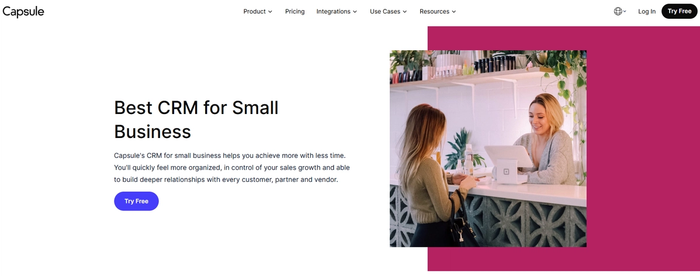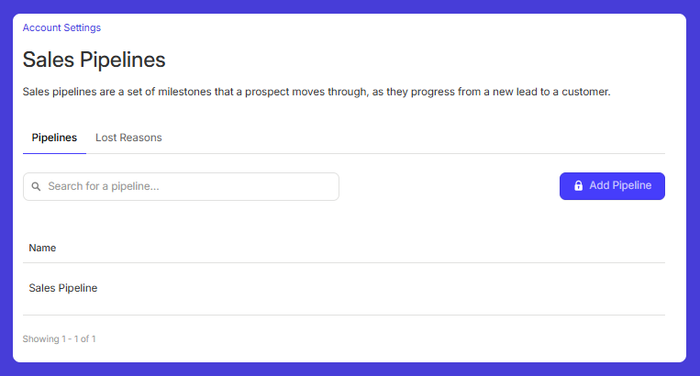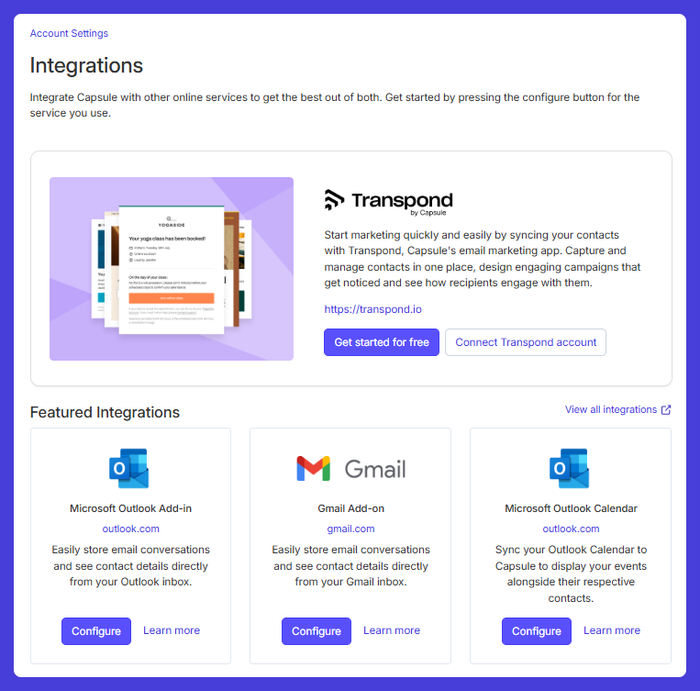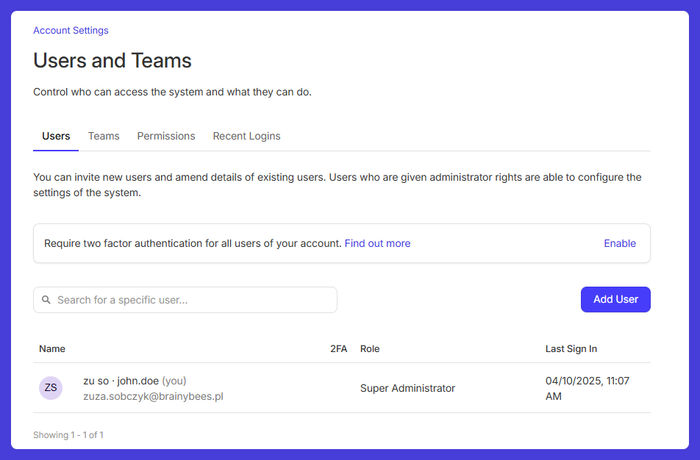Running a small business means keeping track of dozens of moving parts. Names, conversations, orders – it all adds up fast. Some of it ends up in emails, some in spreadsheets, some in your head.
But over time, those scattered details slow you down. A missed follow-up here, a forgotten request there. Small gaps that affect how you serve your customers.
A CRM database helps you pull those details together. In the next sections, we’ll explain what it is, what goes into it, and how it can support your business as you grow.
What is a CRM database?
A CRM database stores all your customer information in one organized system. It connects names, contact details, conversations, purchases, and tasks—so you always know where each relationship stands.
What data goes into a CRM database
- Contact info: names, emails, phone numbers.
- Conversations: past emails, calls, meetings, and even that support ticket from last month.
- Purchases and quotes: what they’ve bought, what they were quoted, and when exactly.
- Requests and issues: customer complaints, service questions, and how they were handled.
- Preferences: who likes phone calls, who prefers emails, and who orders extra in December.
It’s the system that remembers everything – even when you don’t.
Why customer data matters
Customer data helps you be better prepared. It reminds you who prefers monthly reports and who loves real-time dashboards. It tells you when someone last bought, so you know when to check in.
For small businesses, these moments build trust and repeat business. A CRM database makes it easier to keep that connection strong.
Deloitte reports that businesses using customer data for personalization outperform those that don’t. When you have the right details to hand, reaching out feels more natural, and customers notice the extra care.
Why skipping a CRM database costs more than you think
Most small business owners don’t wake up thinking, 'I need a CRM database.' But here’s the thing – 91% of companies with just 10 employees or more are already using one.
And they aren’t using it just to stay organized. Businesses that lean into CRM see real results:
- 29% higher sales
- 34% boost in sales productivity
- 42% better sales forecasting
CRM database is the system behind the scenes making all those numbers possible.
And if you’re thinking, 'I’m too small for that,' here’s another number: 65% of businesses adopt a CRM within their first five years. Honestly the earlier the better!
Read about more benefits here.
Outgrowing spreadsheets: When it's time for a CRM database?
Most small businesses start with spreadsheets to track customer details. It makes sense: they’re simple, familiar, and easy to set up.
But spreadsheets aren’t designed to manage growing relationships.
As your business expands, customer data gets more complex. You need to track conversations, purchases, follow-ups, and tasks that are often shared across a team. Spreadsheets can only take you so far before they become a patchwork of tabs, emails, and sticky notes.
A CRM database steps in when you outgrow that system. It links every piece of customer information into one organized space so you don’t have to dig through old files or duplicate entries. You’ll be able to:
- Access in real time → Everyone on your team sees the same up-to-date records.
- Automate tasks → Set follow-up reminders or update customer statuses without manual work.
- Search and segment easily → Filter customers by purchase history, location, or last interaction.
While spreadsheets work for a while, a CRM database grows with your business. It helps you stay organized, responsive, and focused on building better customer relationships.
Not fully convinced? Read about Spreadsheets vs CRM
How to set up a CRM database in 7 steps
Switching from scattered spreadsheets to an organized CRM sounds like a big leap – but trust us, it’s simpler than it looks. These seven steps will walk you through setting up a CRM database, with examples from Capsule CRM. You’ll see how each step works in practice, so you can follow along or tweak it for your setup.

Step 1: Choose the right CRM software
Before you set up a CRM database, you need a tool that feels right for your business. Not every CRM is designed with small teams or solo owners in mind. Some feel built for big enterprises, full of complex dashboards and jargon you don’t need.
For small businesses, the best CRM does two things well:
- It keeps customer details organized without making your day harder.
- It helps you act on those details – like sending follow-ups or tracking deals – without having to act manually.
Cloud-based CRMs are usually the sweet spot here. They’re flexible, accessible from anywhere, and often tailored for smaller teams. But picking one can feel like comparing apples to oranges.
To help you weigh your options, here’s a guide to the best CRM software for small businesses like yours.
Capsule CRM offers a 14-day free trial (or a forever-free plan) that lets you test-drive features like contact management and sales pipelines.

Step 2: Define what data you need
A CRM database only works if it holds the right information. Too little, and you miss out on insights. Too much, and it turns into a cluttered mess you never want to open.
Think about what really matters to your business. Do you need to know a client’s birthday? Maybe. But knowing when they last purchased, what service they prefer, or if they’re due for a check-in? That’s the kind of data that keeps relationships alive.
Start with the basics: name, email, phone. Then ask yourself:
- What do I wish I’d remembered about this customer last time?
- What helps me serve them better?
- What triggers a follow-up? Is it a past purchase date or contract renewal?
- Do I need to track their preferred way of communicating: phone, email, or even social DMs?
- Are there notes that give context and personal tidbits like 'prefers morning calls'?
Your CRM should let you add custom fields to track exactly what you need. Whether it’s 'Preferred Product,' 'Referred By,' or 'Customer Since.'
In Capsule CRM, go to Account Settings > Custom Fields and tailor your database. Capture the details that make your business personal.

Step 3: Import existing data
Don’t start from scratch. Bring your current customer info with you. Most small businesses already have some data floating around in spreadsheets, email lists, or other tools.
Importing this into your CRM gives you a head start, so:
- Gather your existing contacts (CSV files, email lists, or exports from other systems).
- Upload them into your CRM using the import feature. Capsule CRM, for instance, guides you through People & Organizations > Import Contacts > From a File.
- Use the field mapping tool to match your spreadsheet columns (like 'First Name,' 'Email,' or 'Company') with CRM fields, so nothing gets lost or misaligned.
Before importing, clean up your data. Remove duplicates, fix formatting (like inconsistent phone numbers), and fill in any key gaps. It really saves time down the road!

Step 4: Customize your database
Now that your data has been imported, it’s time to shape the CRM around how you work. Every business is different: what matters to a consultant won’t matter to a bakery or a digital agency.
Start with leads, prospects, and customers, so you know where each contact stands. You can also add tags like 'VIP,' 'Event Attendee,' or 'Long-Term Client' to segment contacts for tailored follow-ups or promotions.
In Capsule CRM, you can add Tags under each contact’s profile and design your sales pipelines under Account Settings > Sales Pipelines to mirror your exact workflow.
Customize sales pipelines to match your process. Whether it’s 'Initial Contact → Proposal → Closed Deal' or something unique, set up stages that reflect how you move clients forward.

Step 5: Integrate with other tools
Don’t let your CRM become an island. Connect it with the tools you already use, like email, accounting software, and marketing platforms, so everything flows together.
This will allow you to:
- See email threads right inside your contact records (no more digging through your inbox).
- Sync with accounting tools to track invoices or payments alongside customer data.
- Connect email marketing platforms to manage campaigns and segment audiences without manual work.
In Capsule CRM, you can integrate Outlook or Transpond under Account Settings > Integrations. This pulls email conversations into the CRM.

Step 6: Train your team
A CRM database works best when everyone uses it the same way. Even the best system can fall apart if your team isn’t confident in entering data correctly. Take time to walk your team through how the CRM works, what data matters, and how to keep things as updated as possible.
In Capsule CRM, you can invite users through Account Settings > Users and Teams and assign specific roles so everyone knows their level of access. From there, lean on Capsule’s built-in help articles and video tutorials to get everyone up to speed.
A short onboarding session now prevents a lot of missed opportunities later.

Step 7: Start using it consistently
Setting up your CRM is just the start. To get real value, you should be using it every day. Log new leads and update records after conversations. This habit keeps your data fresh at all times.
In Capsule CRM, the Dashboard shows your tasks and deals at a glance. The Reports give a quick snapshot of your sales and activity. When you use these tools regularly, your CRM becomes a reliable partner, not just another system.
CRM database maintenance checklist
- Update customer data monthly. Make it part of your routine to check and refresh contact details. Outdated phone numbers or email addresses can lead to bounced emails and wasted follow-ups, which isn’t ideal if you rely on campaigns or client outreach. Set time aside every month to confirm key details with your active contacts.
- Set data entry standards for your team. Decide how things like phone numbers, addresses, and names should be formatted (e.g., always include country codes for phone numbers, use full company names).
- Run regular checks to catch and merge duplicate records, like the same contact entered twice under slightly different names or email addresses.
- Review user access permissions. Regularly check who has access to sensitive customer data. Make sure only the right people can view or edit key records, especially if team roles change.
Conclusion
Bobby Darnell summed it up well: 'Saying, ‘I don’t have time for CRM,’ is like saying, ‘I don’t have time to check my GPS because I’m too busy figuring out how to get there.’'
For small businesses, it’s tempting to push a CRM database down the to-do list. But waiting often costs you more – wasted time trying to piece together customer details.
Putting a CRM database in place means you’re not struggling to keep up.
You can focus on running your business, knowing your customer information is organized and ready when you need it. Capsule CRM makes that part easy, giving you one place to store, track, and build better relationships. So, how about giving it a go?




